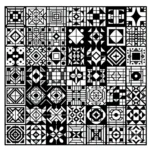The Matrix Analogies Test (MAT) is a renowned assessment tool used to measure the reasoning and problem-solving capabilities of individuals. An essential part of cognitive evaluation processes, the MAT serves as a key indicator of intellectual functioning, particularly in the area of non-verbal reasoning. This article delves into what the Matrix Analogies Test is, how it operates, and why it is considered a valuable instrument in educational and professional settings.
At its core, the Matrix Analogies Test is a type of intelligence test that requires test-takers to complete a series of matrices by identifying patterns and selecting the piece that correctly completes the matrix from a set of options. It falls under the category of inductive reasoning tests, which require the ability to identify relationships, similarities, and differences among groups of objects. By leveraging pattern recognition and logic, individuals demonstrate their capacity for abstract thinking, a skill that transcends linguistic and cultural boundaries.
MAT is based on the principle that intelligence involves the ability to discern patterns and solve novel problems. The test consists of a variety of matrices, each presenting a grid of images or shapes with one element missing. The participant must select the correct element from several alternatives to complete the pattern or sequence. This format means that the MAT does not rely on language, making it an advantageous measure for individuals of varying linguistic backgrounds, as well as for those with specific language impairments.
The origins of the Matrix Analogies Test can be traced back to the early 20th century, with the pioneering work of psychologist Charles Spearman. Spearman introduced the concept of a general intelligence factor, commonly known as the “g factor,” which underlies performance across various cognitive tasks. The MAT is designed to tap into this “g factor” by assessing an individual’s ability to see relationships and solve problems without relying on acquired knowledge.
While the Matrix Analogies Test can be administered to people of virtually any age, there are different versions tailored to specific age ranges. This ensures that the level of difficulty is appropriate and that the test remains challenging yet fair for all participants. For children, the test helps in identifying giftedness and any potential learning difficulties, while for adults, it is often employed for job selection processes or neuropsychological assessments.
In the educational sphere, professionals may use the MAT to identify students who require specialized educational programs. By pinpointing areas of strength and weakness in a student’s cognitive abilities, educators can develop teaching strategies that align with the individual’s learning needs. The MAT also serves as a guide in creating a more personalized and effective educational experience, catering to a diversity of learners.
In the realm of employment, the Matrix Analogies Test is a popular choice among companies wishing to evaluate the problem-solving abilities of potential employees. Given the high premium placed on critical thinking and adaptability in the modern workplace, the MAT offers a clear measure of an individual’s non-verbal reasoning strengths. Businesses may use this information to better understand how a candidate may perform in roles that demand analytical thinking and the capacity to work with complex systems or data.
The MAT is also an essential component in the field of psychology, particularly in neuropsychological assessments. Clinicians administer the test to evaluate the cognitive functioning of individuals who may have suffered brain injury or neurological disorders. The results can reveal insights into the extent of cognitive impairment and assist in planning appropriate rehabilitation or intervention strategies.
What makes the Matrix Analogies Test particularly appealing is its objectivity. The visual nature of the test means that it is not influenced by the test-taker’s educational background, language proficiency, or cultural experiences. This level of fairness increases its applicability and validity across diverse populations. Additionally, the MAT is standardized, meaning that an individual’s performance can be compared to normative data from a large, representative sample. This comparison yields a percentile rank that reflects where the individual stands in relation to others in their demographic group.
The administration of the Matrix Analogies Test is straightforward and usually carried out under timed conditions. A professional, such as a psychologist or trained administrator, typically provides instructions and oversees the test to ensure that its standardized protocol is followed. This contributes to the accuracy and reliability of the results obtained.
Upon completion of the test, the results are evaluated to create a profile of the individual’s non-verbal reasoning skills. These results can provide comprehensive insights into how a person processes information, makes decisions, and solves problems without depending on language or prior specific knowledge. For the test-taker, the insights gained from the results can help them understand their cognitive strengths and identify areas for improvement.
To prepare for the Matrix Analogies Test, individuals can engage in exercises that strengthen pattern recognition and logical reasoning skills. For example, puzzle games, brain teasers, and logic problems can serve as good practice for the type of thinking required by the MAT. While there is no specific content to study, becoming familiar with the test structure and practicing under timed conditions can help test-takers feel more comfortable and confident during the actual assessment.
In conclusion, the Matrix Analogies Test stands out as a robust tool for measuring non-verbal reasoning abilities. Its applicability across age groups, cultures, and languages makes it a cornerstone in cognitive assessments for various purposes, from aiding educational decisions to informing employment selections, and contributing to neuropsychological evaluations. By emphasizing pattern recognition and logical reasoning, the MAT provides insights into an individual’s intellectual capabilities, offering a lens through which to view and enhance cognitive potential. Whether for personal development, educational guidance, or professional placement, the Matrix Analogies Test remains a testament to the enduring relevance of non-verbal intelligence as a measure of human cognitive ability.

